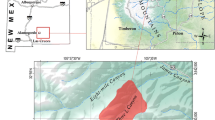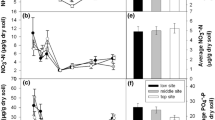Abstract
The seasonal change in soil oxygen availability was determined in several habitats along a topographic moisture gradient in an arctic watershed. The effect of changes in soil aeration on soil chemical and plant properties was examined by comparison of the driest (tussocks) and wettest (wet sedge tundra) sites along this gradient. Spatial variability and seasonal change in soil oxygen availability was closely linked to the hydrologic regime and the thickness of the organic soil horizon. The greatest extension of the aerobic soil layer was found beneath well-drained tussocks, while less than 10% of the unfrozen soil layer is aerated in flooded wet sedge tundra. Intertussock areas and watertracks (channels of water drainage) have intermediate levels of aeration. In tussock tundra, soil oxygen diffusion is restricted in the mineral soil layer below the organic horizon due to reduced pore space. Organic matter constituents and their change with depth were similar beneath tussocks and in wet sedge tundra, indicating that factors other than soil aeration (e.g. low soil temperatures, short growing season) are the primary controls on decomposition in these two arctic tundra systems. NH4 +, the dominant form of inorganic N, was more available in wet sedge tundra than in tussock tundra. At both sites, extractable and soil solution NO3 - concentrations increased 4 to 8 fold in the second part of the growing season, indicating increased nitrifier activity with improved soil oxygen availability. Although soils thawed as deep as 60 cm, approx. 90% of the root biomass was concentrated within 20 cm of the surface. Despite the anaerobic soil environment in wet sedge tundra, the dominant species there, Eriophorum angustifolium, reached slightly greater rooting depths than E. vaginatum, whose roots grow in the elevated, aerobic portion of tussocks. E. angustifolium had a root porosity of 31%, within the range found for wetland species, while roots of E. vaginatum had a porosity close to 12%. Rhizome porosity were low in both species (11%).
Similar content being viewed by others
References
Armstrong W 1967 The relationship between oxidation-reduction potentials and oxygen diffusion levels in some waterlogged organic soils. J. Soil Sci. 18, 27–34.
Armstrong W 1979 Aeration in higher plants. Adv. Bot. Res. 7, 225–332.
Armstrong W, Booth T C, Priestly P and Reed D J 1976 The relationship between soil aeration, stability and growth of Sitka spruce on upland peaty soils. J. Appl. Ecol. 13, 585–591.
Berg B and Staaf H 1981 Leaching accumulation and release of nitrogen in decomposing forest litter. In Terrestrial Nitrogen Cycles: Processes, Ecosystem Strategies and Management Impacts. Eds. F E Clark and T Rosswall. pp 163–179. Ecol. Bull., Stockholm, Sweden.
Billings W D, Luken J O, Mortensen D A and Peterson K M 1983 Increasing atmospheric carbon dioxide: possible effects on arctic tundra. Oecologia 58, 286–289.
Bliss L C and Peterson K M 1992 Plant succession, competition and the physiological constraints of species in the Arctic. In Arctic Ecosystems in a changing Climate. Eds. F S Chapin III et al. pp 111–138. Academic Press, San Diego, USA.
Bremner J M and Mulvaney C S 1982 Total nitrogen. In Methods of Soil Analysis. Part 2. Ed. C A Black. pp 595–622. American Society of America, Madison, WI, USA.
Burdick D M 1989 Root aerenchyma development in Spartina patens in response to flooding. Am. J. Bot. 76, 777–780.
Chapin F SIII, Fetcher N, Kielland K, Everett K R and Linkins A E 1988 Productivity and nutrient cycling of Alaskan tundra: enhancement by flowing water. Ecology 69, 693–702.
Chapin F SIII, vanCleve K and Chapin M C 1979 Soil temperature and nutrient cycling in the tussock growth form of Eriophorum vaginatum. J. Ecol. 67, 169–189.
Damman A W H 1988 Regulation of nitrogen removal and retention in Sphagnum bogs and other peatlands. Oikos 51, 291–305.
Effland J 1977 Modified procedure to determine acid-insoluble lignin in wood and pulp. TAPPI 60, 143–144.
Everet K R and Brown J 1982 Some recent trends in the physical and chemical characterization and mapping of tundra soils, arctic slope of Alaska. Soil Sci. 133, 264–280.
Flanagan P W and Bunnell F L 1980 Microflora activities and decomposition. In An Arctic Ecosystem: The Coastal Tundra at Barrow, Alaska. Eds. J Brown et al. pp 291–334. Dowden, Hutchinson and Ross, Stroudsburg, USA.
Flessa H and Fischer W R 1992 Plant induced changes in the redox potential of rice rhizospheres. Plant and Soil 143, 55–60.
Gebauer L E R, Reynolds J F and Terhunen J D 1995 Growth and allocation of the arctic sedges Eriophorum angustifolium and E. vaginatum: effects of variable soil oxygen and nutrient availability. Oecologia (In press).
Gersper P L, Alexander V, Barkle S A Barsdate R and Flint P S 1980 The soils and their nutrients. In An Arctic Ecosystem: The Coastal Tundra at Barrow, Alaska. Eds. J Brown et al. pp 219–254. Dowden, Hutchinson and Ross, Stroudsburg, USA.
Giblin A E, Nadelhoffer K J, Shaver G R, Laundre J A and McKerrow A J 1991 Biogeochemical diversity along a ariverside toposequence in arctic Alaska. Ecol. Monogr. 61, 415–435.
Glinski J and Stepniewski W 1985 Soil Aeration and its role for Plants. CRC Press, Boca. Raton, FL, USA. 229 p.
Hastings S J, Luchessa S A, Oechel W C and Tenhunen J D 1989 Standing biomass and production in water track drainages of the foothills of the Philip Smith Mountains, Alaska. Holarct. Ecol. 12, 304–311.
Hinzman L D, Kane D L, Gieck R E and Everett K R 1991 Hydrologic and thermal properties of the active layer in the Alaskan Arctic. Cold Region Sci. Technol. 19, 95–110.
Jensen C R, Luxmoore R J, VanGundy S D and Stolzy L H 1969 Root air space measurements by a pygnometer method. Agron. J. 61, 474–475.
Justin S H F and Armstrong W 1987 The anatomical characteristics of roots and plant response to soil flooding. New Phytol. 106, 465–495.
Kielland K 1990 Processes controlling nitrogen release and turnover in Arctic tundra. PhD Diss, University of Alaska, Fairbanks, USA.
Kummerow J, Ellis B A, Kummerow S and Chapin F SIII 1983 Spring growth of shoots and roots in shrubs of an Alaskan muskeg. Am. J. Bot. 70, 1509–1515.
Laan P, Berrevoets M J, Lythe S, Armstrong W and Blom C W P 1989 Root morphology and aerenchyma formation as indicators of the flood-tolerance of Rumex species. J. Ecol. 77, 693–703.
Leadley P N 1994 Modeling the response of arctic vegetation to disturbance: a hierarchical approach. PhD Diss, University of California, Davis, USA.
Lieffers V J and Rothwell R L 1987 Rooting of peatland black spruce and tamarack in relation to depth of water. Can. J. Bot. 65, 817–821.
McClaugherty C and Berg B 1987 Cellulose, lignin and nitrogen concentrations as rate regulating factors in late stages of forest litter decomposition. Pedobiologia 30, 101–112.
Megonigal J P and Day F P 1992 Effects of flooding on root and shoot production of bald cypress in large experimental enclosures. Ecology 73, 1182–1193.
Melillo J M, Aber J D, Linkins A E, Ricca A, Fry B and Nadelhoffer K J 1989 Carbon and nitrogen dynamics along the decay continuum: Plant litter to soil organic matter. Plant and Soil 115, 189–198.
Nadelhoffer K J, Giblin A E, Shaver G R and Linkins A E 1992 Microbial processes and plant nutrient availability in arctic soils. In Arctic Ecosystems in a changing Climate. Eds. F S Chapin III et al. pp 281–300. Academic Press, San Diego, USA.
Oberbauer S F, Gillespie C T, Cheng W, Gebauer R, Sala Serra A and Tenhunen J D 1992 Environmental effects on CO2 efflux from riparian tundra in the northern foothills of the Brooks Range, Alaska, USA. Oecologia 92, 568–577.
Oechel W C and Billings W D 1992 Effects of global change on the carbon balance of arctic plants and ecosystems. In Arctic Ecosystems in a changing Climate. Eds. F S Chapin III et al. pp 139–168. Academic Press, San Diego, USA.
Paul E A and Clark F E 1989 Soil Microbiology and Biochemistry. Academic Press, San Diego. 273 p.
Peterson K M and Billings W D 1980 Tundra vegetational patterns and succession in relation to microtopography near Atkasuk, Alaska. Arct. Alp. Res. 12, 473–482.
Ponnamperuma F N 1972 The chemistry of submerged soils. Adv. Agron. 24, 29–96.
Reddy K R and Graetz D A 1988 Carbon and nitrogen dynamics in wetland soils. In The ecology and management of wetlands. Vol. 1: Ecology of wetlands. Eds. D Hook et al. pp 307–318. Croom Helm Ltd., Breckenham, UK.
Reddy K R, Patrick W H J and Lindau C W 1989 Nitrification-denitrification at the plant root-sediment interface in wetlands. Limnol. Oceanogr. 34, 1004–1013.
Schlesinger W H 1991 Biogeochemistry: An analysis of global Change. Academic Press, San Diego, USA. 443p.
Shaver G R and Cutler J C 1979 The vertical distribution of phytomass in cottongrass tundra. Arct. Alp. Res. 11, 335–342.
Smirnoff N and Crawford R M M 1983 Variations in the structure and response to flooding of root aerenchyma in some wetland plants. Ann. Bot. 51, 237–249.
Stuart L and Miller P C 1982 Soil oxygen flux measured polarographically in an Alaskan tussock tundra. Holarct. Ecol. 5, 139–144.
Swift M J, Heal O W and Anderson J M 1979 Decomposition in terrestrial Ecosystems. University California Press, Berkeley, USA 72p.
Walker D A, Binnian E, Evans B M, Lederer N D, Nordstrand E and Webber P J 1989 Terrain, vegetation, and landscape evolution of the R4D research site, Brooks Range Foothills, Alaska. Holarct. Ecol. 12, 238–261.
Walker D A and Walker M D 1991 History and pattern of disturbance in Alaskan Arctic terrestrial ecosystems: A hierarchical approach to analyzing landscape change. J. Appl. Ecol. 28, 244–276.
Webber P J 1978 Spatial and temporal variation of the vegetation and its productivity, Barrow, Alaska. In Vegetation and Production Ecology of an Alaskan Arctic Tundra. Ed. L L Tieszen. pp 37–112. Springer-Verlag, New York, USA.
Author information
Authors and Affiliations
Rights and permissions
About this article
Cite this article
Gebauer, R.L.E., Tenhunen, J.D. & Reynolds, J.F. Soil aeration in relation to soil physical properties, nitrogen availability, and root characteristics within an arctic watershed. Plant Soil 178, 37–48 (1996). https://doi.org/10.1007/BF00011161
Received:
Accepted:
Issue Date:
DOI: https://doi.org/10.1007/BF00011161




